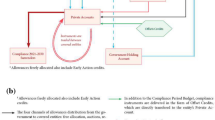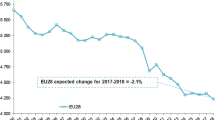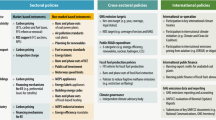Abstract
This paper deals with an application of the robust equilibrium concept in game theory to the assessment of the possible international agreement on climate that could be achieved in the conference of the parties negotiations organized by the UNFCCC. It is shown in particular that an acceptable, self-enforcing agreement could be obtained to maintain the temperature rise below 2\(\,^\circ \)C at the end of twenty-first century, with a balanced welfare loss among 11 groups of countries representing the parties limited to 1.8 % of their total discounted household consumption. To design this possible agreement we use a reduced order meta game where the players are the 11 groups of countries considered as the parties in negotiation, the strategies are the supply of emission quotas on an international emissions trading system and the payoffs are the net gains obtained from the emissions, trading and changes in the terms of trade minus the damage cost associated with the cumulative emissions during the 2010–2050 period. To identify the abatement costs that serve in the calculation of the payoffs and the gains due changes of terms of trade we use a statistical emulation of the GEMINI-E3 macroeconomic model. To obtain surrogate damage cost functions we introduce a coupled constraint in the game, imposing a limit to the cumulative emissions of all parties, which we call the global safety emissions budget. The multipliers intervening in the equilibrium necessary conditions are then interpreted as marginal damage costs. Games with coupled constraints admit a manifold of normalized equilibria and we show that they correspond to equilibria in games where each player is constrained by a given share of the safety emissions budget. Among all the normalized equilibria we look for the one which minimizes the maximum welfare loss, expressed in percentage of household consumption, among the 11 groups of countries. To take into account the uncertainty created by the statistical emulation approach and the approximate description of the emissions trading system we introduce robustness in the equilibrium computation.


Similar content being viewed by others
Notes
United Nations Framework Convention on Climate Change.
Karush Kuhn Tucker.
It is broadly defined as the equilibrium global mean surface temperature change following a doubling of atmospheric CO\(_2\) concentration (http://www.ipcc.ch/publications_and_data/ar4/wg1/en/ch8s8-6.html).
More precisely would be an affine function of cumulative emissions up to 2050. Note that linearity assumption may not remain after 2050, especially in the presence of climate thresholds.
This climate module which is now part of the TIAM-WORLD model that succeeded to the World-Markal model, was relatively optimistic, compared to more complex climate models in its temperature change calculations.
In our numerical illustration presented in Sect. 5, the annual discount factor is equal to 3 %.
We recall in Appendix A the precise definitions of the various equilibrium concepts used in this paper.
This criterion is computed from a simulation made on a CGE, namely GEMINI-E3 (Bernard and Vielle 2008).
See again Appendix A for a characterization of equilibria under coupled constraints.
All information about the model can be found at http://gemini-e3.epfl.ch, including its complete description.
We used space filling methods (generalized latin squares) to generate these scenarios.
We compute a distance indicator to the balanced equilibrium equal to \(\sum _i |\theta _j-\theta _j^*|\), this indicator is respectively equal for the equalitarian, sovereignty and ability to pay rule to 0.58, 0.09 and 0.2.
References
Aghassi M, Bertsimas D (2006) Robust game theory. Math Progr Ser B 107:231–273
Babonneau F, Vial J-P, Apparigliato R (2010) Robust optimization for environmental and energy planning. In: Filar JA, Haurie A (eds) Uncertainty and environmental decision making. Springer, Berlin
Bahn O, Haurie A (2008) A class of games with coupled constraints to model international GHG emission agreements. Int Game Theory Rev 10(4):337–362
Barnetta J, Dessaib S, Webber M (2004) Will OPEC lose from the Kyoto Protocol? Energy Policy 32: 2077–2088
Baumert KA, Blanchard O, Llosa S, Perkaus JF (eds) (2002) Building on the Kyoto Protocol: options for protecting the climate. World Resources Institute, Washington, D.C.
Ben-Tal A, El Ghaoui L, Nemirovski A (2009) Robust Optimization. Princeton University Press, Princeton
Bernard A, Vielle M (2008) GEMINI-E3, a general equilibrium model of international national interactions between economy. Energy Environ Comput Manag Sci 5:173–206
Bernard A, Vielle M (2003) Measuring the welfare cost of climate change policies: a comparative assessment based on the computable general equilibrium model GEMINI-E3. Environ Model Assess 8:199–217
Böhringer C, Helm C (2008) On the fair division of greenhouse gas abatement cost. Resour Energy Econ 30(2):260–276
Böhringer C, Rutherford TF (2002) Carbon abatement and international spillovers. Environ Resour Econ 22:391–417
Carbone JC, Helm C, Rutherford TF (2009) The case for international emission trade in the absence of cooperative climate policy. J Environ Econ Manag 58(3):266–280
Drouet L, Haurie A, Moresino F, Vial J-P, Vielle M, Viguier L (2008) An oracle based method to compute a coupled equilibrium in a model of international climate policy. Comput Manag Sci Spec Issue Manag Energy Environ 5(1):67–94
Drouet L, Haurie A, Vial J-P, Vielle M (2011) A game of international climate policy solved by a homogenous oracle-based method for variational inequalities. In: Breton M, Szajowski K (eds) Advances in dynamic games, vol 11. Annals of the International Society of Dynamic Games, Birkhaüser, pp 469–488
Energy Information Administration. International Energy Outlook US, Department of Energy (2011)
Haurie A, Babonneau F, Edwards N, Holden PB, Kanudia A, Labriet M, Pizzileo B, Vielle M (2013) Fairness in climate negotiations: a meta-game analysis based on community integrated assessment. In: Semmler W, Bernard L (eds) Handbook on the macroeconomics of climate change. Oxford University Press, Oxford
Helm C (2003) International emissions trading with endogenous allowance choices. J Public Econ 87: 2737–2747
Holden PB, Edwards NR (2010) Dimensionally reduced emulation of an AOGCM for application to integrated assessment modelling. Geophys Res Lett L21707. doi:10.1029/2010GL045137
Holden PB, Edwards NR, Oliver KIC, Lenton TM, Wilkinson RD (2010) A probabilistic calibration of climate sensitivity and terrestrial carbon change in GENIE-1. Clim Dyn 35:785–806. doi:10.1007/s00382-009-0630-8
Holden P, Edwards N, Garthwaite P, Fraedrich K, Lunkeit F, Kirk E, Labriet M, Kanudia A, Babonneau F (2013) PLASIM-ENTSem: a spatiotemporal emulator of future climate for impacts assessment. In: Geoscientific model development discussions, pp 63349–3380
International Energy Agency (2011) CO\(_2\) Emissions from Fuel Combustion HIGHLIGHTS, IEA, Statistics, 2011
Kasa S, Gullberg AT, Heggelund G (2008) The Group of 77 in the international climate negotiations: recent developments and future directions. Int Environ Agreem Polit Law Econ 8:113–127
Labriet M, Loulou R (2003) Coupling climate damages and GHG abatement costs in a linear programming framework. Environ Model Assess 8:261–274
Labriet M, Loulou R (2008) How crucial is cooperation in mitigating world climate? Analysis with world-MARKAL. Comput Manag Sci Spec Issue Manag Energy Environ 5(1):67–94
Meinshausen M, Meinshausen N, Hare W, Raper S, Frieler K, Knutti R, Frame D, Allen M (2009) Greenhouse-gas emission targets for limiting global warming to 2\(\,^\circ \)C. Nature 458:1158–1163
Matthews HD, Gillett NP, Stott PA, Zickfeld K (2009) The proportionality of global warming to cumulative carbon emissions. Nature 459:829–832
Nahorski Z, Horabik J (2012) A market for pollution emission permits with low accuracy of emission estimates. Adv Intell Soft Comput 121:149–163
Narayanan, Aguiar, McDougall (eds) (2012) Global trade, assistance, and production: the GTAP 8 data base. Center for Global Trade Analysis, Purdue University
Nordhaus WD, Boyer J (1999) Roll the DICE again: the economics of global warming. Yale University, New Haven
Paltsev S, Reilly JM, Jacoby HD, Morris JF (2009) The cost of climate policy in the United States. Energy Econ 31(Supplement 2):S235–S243
Rawls J (1971) A theory of justice. Harvard University Press, Cambridge
Rosen JB (1965) Existence and uniqueness of equilibrium points for concave N-person games. Econometrica 33(3):520–534
Rypdal K, Winiwarter W (2001) Uncertainties in greenhouse gas emission inventories—evaluation, comparability and implications. Environ Sci Policy 4:107–116
Tol RS (2002a) Estimates of the damage costs of climate change. Part I: Benchmark estimates. Environ Resour Econ 21:47–73
Tol RS (2002b) Estimates of the damage costs of climate change. Part II: Dynamic estimates. Environ Resour Econ 21:135–160
United Nations, Department of Economic and Social Affairs, Population Division (2011) World Population Prospects: The 2010 Revision 2011
UNEP (2012) The Emissions Gap Report 2012. United Nations Environment Programme (UNEP), Nairobi
van Vuuren DP, Stehfest E, den Elzen MGJ, Kram T, van Vliet J, Deetman S, Isaac M, Goldewijk K, Hof A, Mendoza Beltran A, Oostenrijk R, van Ruijven B (2011) RCP2.6: exploring the possibility to keep global mean temperature increase below 2\(\,^\circ \)C. Clim Change 109(1–2):95–116
van Vuuren DP, Edmonds J, Kainuma M, Riahi K, Thomson A, Hibbard K, Hurtt GC, Kram T, Krey V, Lamarque J-F, Masui T, Meinshausen M, Nakicenovic N, Smith SJ, Rose SK (2011) The representative concentration pathways: an overview. Clim Change 109:5–31
Yi W-J, Zou L-L, Guo J, Wang K, Wei Y-M (2011) How can China reach its CO\(_2\) intensity reduction targets by 2020? A regional allocation based on equity and development. Energy Policy 39:2407–2415
Author information
Authors and Affiliations
Corresponding author
Additional information
The research leading to these results has received funding from the EU Seventh Framework Programme (ERMITAGE FP7/2011–2013) under Grant Agreement No. 265170, and GICC programme of the French Ministry of Ecology, Sustainable Development and Energy/2009–2011. We thank Cédric Philibert and José Romero for helpful discussions on the current state and the future of the international negotiation on climate change. We thank Jean-Philippe Vial for his initiation to the beauty of robust optimization and Christopher Andrey for his meticulous reading and for his corrections.
Appendix A: Primer on robust game design
Appendix A: Primer on robust game design
1.1 A.1 From Nash equilibrium to robust Nash equilibrium
We first recall the definition of a Nash equilibrium in a game in normal form. The game is defined by the given of:
-
a set of players \(j=\{1,2,\ldots ,m\}\);
-
a set of strategies \(S_j\) for each player \(j\in M\), where \(S_j\subset \mathbb {R}^{m_j}\) is convex;
-
a set of payoffs \(\phi _j(\mathbf {x}):\mathbf {x}\in \mathbf {S}=\times _{i=1}^m S_i\rightarrow \mathbb {R}\), where we assume that \(\phi _j(\cdot )\) is continuously differentiable and concave in \(x_j\in S_j\) and continuous in \(\mathbf {x}^{-j}=(x_i)_{i\ne j}\).
Definition 1
A Nash equilibrium is a strategy \(m\)-tuple \(\mathbf {x}^{\star } \in \mathbf {S}\) such that, for each player \(j=1,\ldots ,m\), the following holds
where \([\mathbf {x}^{\star -j},x_j])\) is the strategy \(m\)-tuple obtained by replacing in \(\mathbf {x}^{\star }\) the component \(x_j^\star \) by \(x_j\).
If the strategy set of Player \(j\) is defined by a set of inequality constraints
where \(h_j(\cdot ): \mathbb {R}^{m_j}\rightarrow \mathbb {R}^{p_j}\) is continuously differentiable and concave, and under usual constraint qualification conditions, a Nash equilibrium is characterized by the following first order conditions
Now we suppose that the payoff to Player \(j\) is rewritten \(\varphi _j(\mathbf {x},\xi )\), where \(\varphi _j\) is differentiable in \(x_j\) and continuous in \(\mathbf {x}\) and \(\xi _j\). Here \(\xi _j\) is an uncertain parameter which takes value in an uncertainty set \(\Xi _j\) which is supposed to be closed and bounded. We define the robust payoff for Player \(j\) as the worst case function
Definition 2
A robust equilibrium for the game defined by the uncertain payoffs \(\varphi _j(\mathbf {x},\xi _j)\), is a Nash equilibrium for the game defined by the worst-case payoffs \( \phi ^\rho (\mathbf {x})\).
1.2 A.2 From normalized equilibrium to robust normalized equilibrium
We now recall the definition of a normalized equilibrium in a game with coupled constraints. Assume, for the sake of simplicity, that in the game defined above, the strategy sets are \(S_j=\mathbb {R}^{m_j}\). Let a coupled constraint set \(\mathcal{{G}}\subset \times _{i=1}^m S_i \) be defined by a set of inequalities
where \(g(\cdot ): \times _{i=1}^m S_i \rightarrow \mathbb {R}^p\) is continuously differentiable and concave.
Definiton 3
An equilibrium under the coupled constraint (36) is a strategy \(m\)-tuple \(\mathbf {x}^{\star } \in \mathbf {S}\) such that, for each player \(j=1,\ldots ,m\), the following holds
The equilibrium is normalized if there exists a multiplier \(\mu \) and a vector of weights \(\mathbf {r}=(r_j)_{j=1\ldots ,m}\) satisfying
such that the following first order conditions hold
We recall that there may exist a manifold of normalized equilibria, associated with the different possible weights \(\mathbf {r}\).
Now we suppose that an uncertain parameter \(\xi \) enters in the definition of the constraint, which writes now
where the parameter \(\xi \) is element of an uncertainty set \(\Xi \).
We define the robust coupled constraint set \(\mathcal{{G}}^{\rho }\subset \times _{i=1}^m S_i\) defined by the inequalities
where for each component \(k=1, \ldots ,p\)
Definition 4
A robust equilibrium under the uncertain coupled constraint (38) is a strategy \(m\)-tuple \(\mathbf {x}^{\star } \in \mathbf {S}\) such that, for each player \(j=1,\ldots ,m\), the following holds
1.3 A.3 The robust optimal game design problem
Consider a game with coupled constraint and its manifold of normalized equilibria, as defined in Definition 3. Let \(\mathbf {x}^\star (\mathbf {r})\) be the equilibrium corresponding to the weight vector \(\mathbf {r}=(r_j)_{j=1\ldots ,m},\,r_j>0,\,\sum _{j=1}^mr_j =1\).
Assume that there exists an upper-level decision maker who can select the weight vector \(\mathbf {r}\) and who values the equilibrium outcome according to a function
The optimal game design problem consists then in finding the weight vector \(\mathbf {r}\,^\circ \) which solves
The robust optimal game design problem consists then in finding the weight vector \(\mathbf {r}\,^\circ \) which solves (43) where the equilibrium concept is replaced by the robust equilibrium concept defined above.
Rights and permissions
About this article
Cite this article
Babonneau, F., Haurie, A. & Vielle, M. A robust meta-game for climate negotiations. Comput Manag Sci 10, 299–329 (2013). https://doi.org/10.1007/s10287-013-0188-0
Received:
Accepted:
Published:
Issue Date:
DOI: https://doi.org/10.1007/s10287-013-0188-0




